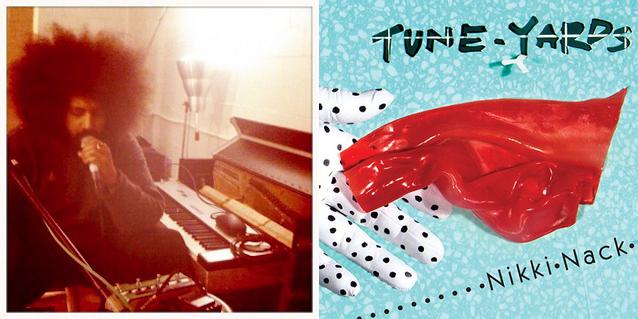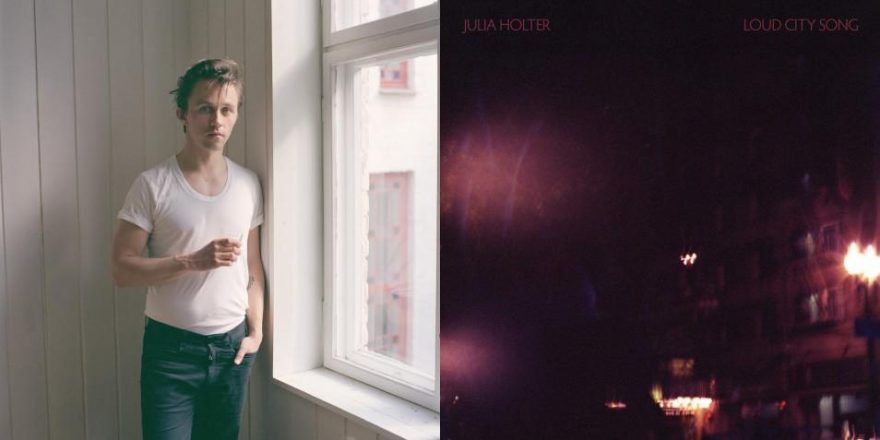I was likely the only person to bring half a left-over corn omelette and a new record by Brian Eno and Underworld’s Karl Hyde to Rockaway Beach the other day. The devastation of Hurricane Sandy is still intensely seen and felt in the area, most glaringly via a huge overground pipeline that stretches across the beautiful beach. On this particular day, the huge pipeline, which was covered in graffiti words of warning, was spewing out filthy, dark brown water that soaked into the fine, white sand. Adorable nearby beach police patrol officers appeared unfazed by this, so I gathered it was nothing to worry about and walked just a frisbee-throw away to lie down, among the many other merry people who had taken to the beach on this sun-drenched Friday.
Nearby, three gorgeous ladies had finally mustered the confidence to go topless, if only for a few minutes. An older man was rudely awoken by a wave that washed in much stronger and further than any of us had anticipated. I took heed and moved away from the water, closer to that disgusting pipeline. Just before I closed my eyes to take in High Life — Eno and Hyde’s second collaboration this year — a beach parasol came tumbling through the air, offering me the chance to play the hero by catching the moving object ungraciously but efficiently before it could hurt a nearby woman and perhaps also endanger my omelette. Now, if I only my surroundings would let me, I might be able to enjoy some high life.
The reason I thought it might be interesting to write about this record — and, ideally, for you to read about it —was because I assumed the music might be of a sort that I appreciate with curiosity and exotic distance. I reckoned I wouldn’t be bogged down by excessive nerdy knowledge, too many references or the nostalgic insider’s overwrought vocabulary relating to the respective works of Brian Eno & Karl Hyde. And yet here I am — only a minute into the first song, “Return,” instantly comparing what I’m hearing to other things I have heard and known. I suppose we are always looking to relate new experiences to those of the past.
“Return,” with its jangly but persistent DI-sounding guitars and murmured, minimal vocals, immediately called to my mind the Durutti Column. Several of the sounds feel sonically primitive, home-recorded, at times even jarring, all of which offers welcome resistance to what could easily just have been a nine-minute smooth experimental adult contemporary jam. It becomes something far more interesting. The unfortunate pipeline already a distant memory, I’m having an excellent time on the beach, so far.
“DBF” is a relatively brief instrumental that immediately reminds me of some of my favorite elements of Remain in Light: the chopped-up guitar riffs, the driving yet static drum beat, long bass notes that overtake the recording and radically change the harmonic context of the simple, constant melodic patterns that populate the song. For lack of actual words, “DBF” is wonderfully blippy, fetching and concise. I realize now that it’s my favorite track on the record.
These two opening songs indicate that this is unlikely to be among the most progressive or influential albums either Hyde or Eno have been involved in. (Full disclosure: my favorite Eno production is probably Coldplay’s “Viva la Vida”; the only Underworld song I truly know is “Born Slippy”). So far, High Life is feeling more driven by a communal vibe and the liberating joys of collaboration than a need to make waves or push things forward. It’s been 35 years since Eno and Talking Heads bridged the divide between nerdy, anxious New York hipsters and dark, nimble polyrhythmic African music. Nowadays everyone’s doing it, so it’s difficult to think of a reason why Eno shouldn’t be allowed to bring a new friend to the party and just enjoy himself.
“Time to Waste It” features the most fascinating vocal effect I’ve heard in some time. I’m not sure if the female singer featured here is an old sample, a field recording or something composed and recorded specifically for this song. Either way, the vocals sound as if they’re from a DAT tape that’s been buried under a beach for 30 years, just like that repulsive pipeline behind me that I had almost forgotten about. Perhaps the DAT tape washed ashore during a violent hurricane? The effects feel somehow both digital, analogue, warm, robotic and lived-in. I kept wondering if part of the effect is simply the singer’s natural vibrato, or if it’s all artifice. It’s such an intensely heartfelt, vulnerable and extreme performance. Whatever’s going on here, it’s a low-key revelation. The guitars play the same licks throughout most of the song’s eight minutes. Distorted and atmospherics clouds of sound wash over you and then vanish. The rhythm track is quite dull. Life continues. Very little else happens. It’s absolutely terrific.
One could argue that it’s interesting to read musicians’ takes on other musicians’ work because we are likely to have intimate insight into some of what’s at play. Well, that may sometimes be true, but it’s occasionally also what makes listening to records a less mythical and magical experience for me. On the track “Lilac” I kept letting myself be bothered by what I identify as excessive duplication tricks of little guitar ticks and giggles that bombard the song. To me, these effects call to mind the era, in my late teens, when I started recording myself using the revolutionary recording software Pro Tools. So exciting and intoxicating was this new toolbox that allowed me to cut up, duplicate, manipulate and fuck up any little sound I made, that I considered for a moment if maybe my true calling was that of a third-rate home-studio-version of wizards like Cornelius or Beck. (Thankfully I snapped out of any such illusions quickly. Recording myself bores me tremendously.) When Eno and others pioneered this kind of freedom and manipulation, many years before Pro Tools made it accessible, even to people like teenaged me, it naturally required a lot more deliberation and patience than it does in our time. Which is why it sounds strange to me when I detect Eno using some seemingly banal duplication effects. It reminds me of silly things I used to overindulge in back in 2000. But for all I know, I don’t know what I’m talking about. And either way, these effects may bring mystery and excitement to other listeners. In which case, please ignore what I just said. But while I’m at it: “Lilac” practically screams out for a more charismatic and expressive singer, someone like Byrne or Elvis Costello. (Have you heard the Eno/Costello collaboration “My Dark Life”? It’s fantastic.)
Similar problems continue on the next track, “Moulded Life,” which sounds a lot like one of the many exhausting spoken skits on David Bowie’s undervalued, often brilliant 1995 concept album Outside, which was produced by Brian Eno. The programming and drum sounds here are so ’90s-cyber-vulgar and plastic, it cannot be without intent. There’s even a jarring sound reminiscent of one of the things the fox says in that song by Ylvis, the Norwegian comedy duo. Similarly, this is one song I don’t think I’ll ever need to hear again.
The closing number, “Cells & Bells,” led me to think of both Penguin Cafe Orchestra, some of Brian Reitzell’s recent television scores and Nightlands, the side project of War on Drugs bassist Dave Hartley. The song is based around a digital drone and mantra-like robotic vocal lines, crooned eerily by Eno (and Hyde?), repeated, like a ritual you’re not sure you want to be a part of, but can’t escape. It’s quite spellbinding and would easily last much longer than its almost eight minutes if it were up to me.
For a moment I forgot where I was. I forgot the sun was up high. That I was probably getting sun-burned again. And that the pipeline was still there, right behind me, spewing out crap. It was a beautiful day at the beach. It was high life.









